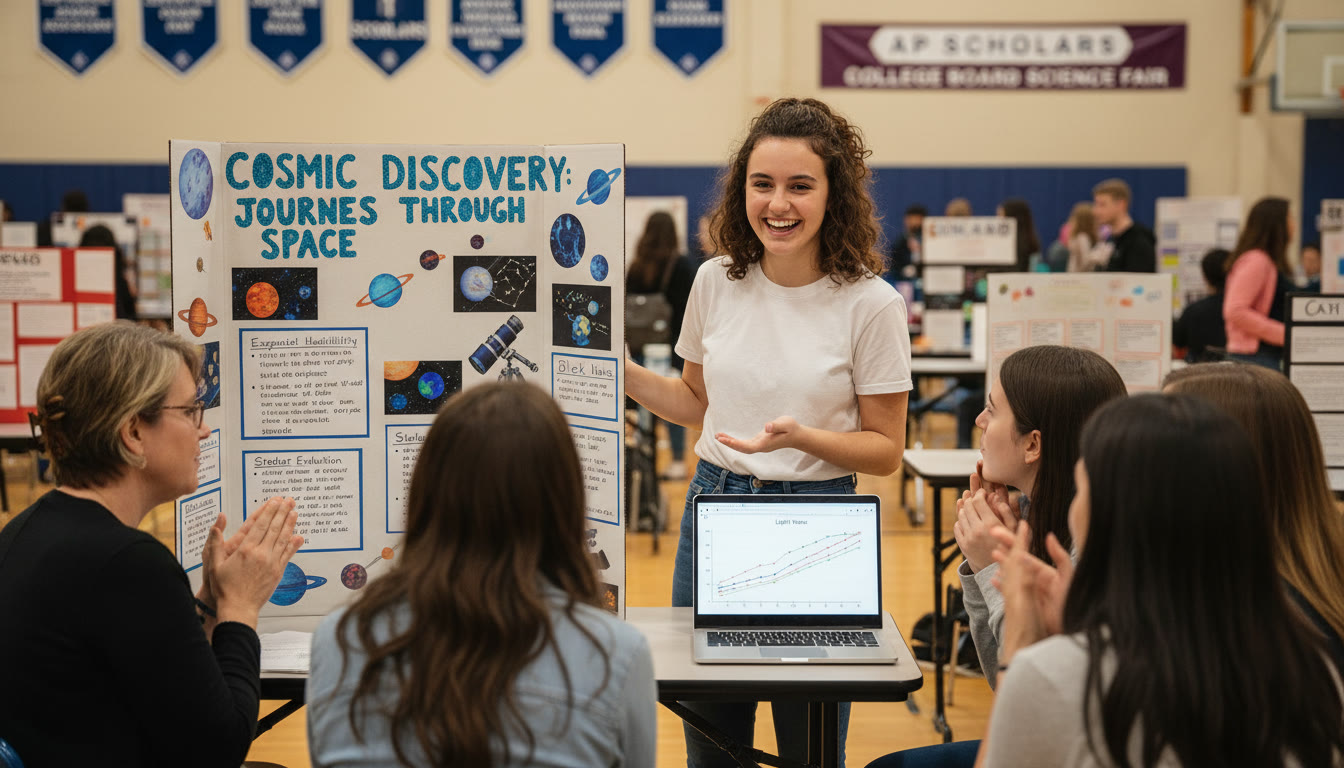Why AP Project Weeks Matter More Than You Think
Project weeks—the frantic, brilliant stretch when science fairs, hackathons, and AP Capstone milestones collide—are more than a deliverable. They’re a laboratory for skills colleges actually care about: curiosity, problem solving, communication, and intellectual independence. For AP students, these weeks are also a chance to produce artifacts that show up on applications, in interviews, and on your own confidence report card.
Whether you’re prepping an AP Research academic paper, leading a team at a regional hackathon, or building a prototype for a science fair, the work you do in this short window can define your learning trajectory for months. Done well, it becomes a story: an inquisitive student who asked a hard question, tried a few approaches, iterated through failure, and delivered a thoughtful product or paper.

Three Roles You’re Playing All at Once
During AP project weeks you are simultaneously:
- A researcher: collecting evidence, analyzing results, and ensuring ethical practices, especially if human subjects are involved.
- An engineer or designer: building, testing, and iterating prototypes or experiments under constraints.
- A storyteller: packaging complex work into a narrative judges, teachers, and admissions officers can understand.
Balancing those roles is the key to turning a good project into a memorable, high-impact one.
Plan Like a Scientist, Present Like an Artist
Start with a plan that’s realistic for your timeline and resources. Large scope is tempting—everyone wants a breakthrough—but clarity and execution beat over-ambition every time. Below is a practical roadmap you can adapt whether you’re doing AP Research, an independent science fair project, or a 24–48 hour hackathon.
Project Roadmap: A Week-By-Week Breakdown
This template assumes a 6–8 week window leading up to a major presentation or submission, which is typical for AP project preparations.
| Week | Focus | Deliverable |
|---|---|---|
| 1 | Define question and scope | Research question, hypothesis, one-page plan |
| 2 | Background research and ethics | Annotated bibliography or literature summary |
| 3 | Design and materials | Method outline and materials list |
| 4 | Data collection / prototyping | Raw data or working prototype |
| 5 | Analysis and iteration | Preliminary results, revised methods |
| 6 | Write-up and visuals | Draft paper, slides, poster |
| 7 | Practice and polish | Rehearsed presentation, final materials |
Adjust the timeline for a 48-hour hackathon by compressing each stage into focused sprints: define, prototype, test, and pitch. For AP Research, expand the analysis and write-up phases to match the 4,000–5,000 word expectation.
Designing Experiments and Prototypes That Tell a Story
Experimental design and prototypes must be more than technically correct; they must communicate why you made the choices you did. Think about three elements when planning:
- Clarity: Is your independent variable and outcome measure crystal clear?
- Reproducibility: Could another student repeat your method with the same materials and get similar results?
- Ethics and safety: Have you vetted protocols involving people, animals, or hazardous materials with your teacher or institutional board?
For hackathons, replace reproducibility with robustness: make sure your demo handles typical failure modes and degrades gracefully. Judges appreciate a demo that gracefully reports an error rather than one that crashes without explanation.
Example: From Question to Prototype
Imagine you want to study plant growth under different LED spectra for a science fair and build a monitoring app for a hackathon. Combine the goals: set a clear hypothesis—”Plants exposed to red-heavy LEDs will grow taller but have less leaf area than plants under full-spectrum light over four weeks”—and design both an experiment (pots, measured light levels, watering schedule) and a prototype app that logs data, visualizes growth curves, and alerts users to anomalies. The pairing shows interdisciplinary thinking and makes for a compelling presentation.
Research Integrity, Data Management, and the AP Capstone Context
AP Seminar and AP Research emphasize intellectual honesty and documented processes. Keep a lab notebook—digital or physical—with dated entries. Save raw files in labeled folders and back them up. Document decisions, failed trials, and why you changed protocols. This trail is not only useful to you but required if your teacher needs to affirm the authenticity of your work.
Practical Data Management Tips
- Use standardized file names and a single folder structure from day one.
- Export raw data in open formats (CSV for spreadsheets, PNG/JPEG for images with clear labels).
- Keep a README file explaining data columns, units, and any processing steps.
- Make short, dated video logs for major milestones—these are excellent evidence of process and help when writing reflections or defense statements.
Presentation Mastery: Posters, Pitches, and Defenses
Presentation is where your months of work become legible to others. Different formats have different expectations:
- Science Fair Poster: Clear hypothesis, crisp methods, readable figures, and a concise conclusion. Leave room for judges to scan and for you to tell the deeper story during Q&A.
- Hackathon Pitch: A 3–5 minute narrative: problem, solution, demo, impact, and the ask (what you need next). End with a memorable line and a call to action.
- AP Research Defense: Know your literature, limitations, and the broader implications. Prepare answers to likely statistical or methodological critiques.
Slide and Poster Checklists
- Use large fonts and bold headings for posters; people often view them from a distance.
- Limit slides to one idea each; keep visuals simple and readable.
- Practice delivering the core narrative in 60 seconds—the “elevator pitch”—and in 10 minutes, which is often your maximum for judging panels or classroom defenses.
Grading, Scoring, and What Judges Really Look For
Judges evaluate more than “results.” They weigh how well you designed and controlled an experiment, how you interpreted uncertainty, and whether you can articulate next steps. For AP Research, the scoring rubric places a high premium on scholarly rigor and clear communication. In hackathons, feasibility and impact often score higher than technical novelty.
Common Pitfalls to Avoid
- Overfitting your analysis to get the result you wanted—let the data show the pattern, even if it contradicts your hypothesis.
- Ignoring simple controls—sometimes a small control group or baseline test answers the biggest questions.
- Long slides or crowded posters—simplicity aids comprehension and leaves room for your verbal commentary to add texture.
Collaboration, Team Roles, and Conflict Resolution
Team projects are microcosms of future college group work. Successful teams define roles early (project manager, data lead, build lead, presentation lead) and set communication norms. Use quick daily stand-ups to reduce miscommunication and a shared document where everyone tracks tasks and deadlines.
Sample Team Role Table
| Role | Responsibilities | When to Step In |
|---|---|---|
| Project Manager | Coordinates timeline, checks milestones, interfaces with mentors | If deadlines slip or tasks are unclear |
| Research Lead | Designs methodology, oversees data collection | When protocol questions or ethics issues arise |
| Build/Prototype Lead | Codes or assembles prototype and handles demos | During integration, testing, and final demos |
| Communication Lead | Creates poster/slides and practices pitch | Before final presentation and during Q&A prep |
How to Use Feedback Without Losing Your Voice
Feedback is gold—but it’s also noisy. Learn to triage: prioritize comments that focus on the core research question, methodology, and clarity of presentation. Keep a changelog: what you changed, why, and who suggested it. That log is especially powerful for AP defenses and teacher checkpoints because it shows deliberate, reflective revision.
Time Management During Crunch Week
Crunch week is a marathon disguised as a sprint. Here’s a sustainable approach:
- Schedule blocks of focused work (Pomodoro or 50/10) and protect 7–8 hours of sleep—cognitive tasks collapse when you’re exhausted.
- Prioritize high-impact tasks first: fixing a broken method or clarifying a confusing graph is more valuable than polishing font choices.
- Use rapid peer checks: 15-minute sessions with classmates to spot glaring issues quickly.
Polishing the Narrative: Writing Your Abstract and Reflection
An abstract and reflection are often the first and last things a judge or teacher reads. The abstract answers: what you did, why it matters, and what you learned. The reflection explains the process: decisions, surprises, limitations, and next steps. For AP Research, this reflective element is central to the course’s goals.
Abstract Template
In one to three sentences: state the question. In one to three sentences: summarize methods. In one or two sentences: highlight the main result and its significance. End with a brief sentence about limitations or implications.
Leverage Expert Help Strategically
Getting outside input is smart; the key is targeted tutoring, not wholesale rewrites. Personalized 1-on-1 guidance can accelerate learning because it addresses precisely where you’re stuck—experimental design, statistical analysis, or presentation coaching. For many students, a tailored study plan from an expert tutor turns a vague sense of “I need help” into concrete, achievable steps. Sparkl’s personalized tutoring, for instance, can provide focused 1-on-1 coaching, tailored study plans, expert tutors who understand AP expectations, and AI-driven insights that help you track progress and troubleshoot problem areas efficiently. Use these supports to deepen understanding while keeping ownership of your work.
Real-World Context: Turning an AP Project Into Something Bigger
College admissions committees love projects that transcend course requirements—projects that connect to community needs, entrepreneurial ventures, or continued research. Consider these pathways:
- Community Implementation: Turn a health-orientation study into a school wellness program pilot.
- Open Source: Release your hackathon code on a public repo with clear documentation to demonstrate sustained impact.
- Publication: Submit a short article to a local science journal, student research showcase, or the school newspaper to show dissemination.
Example Pathways
A student who developed low-cost water sensors for a science fair later partnered with a local environmental group to deploy a small pilot—this turned a classroom project into a community initiative. Another student used hackathon momentum to build a mental health resource chatbot, refined it through user testing, and included metrics from a pilot study in their AP Research paper. Both stories show initiative, scalability, and impact—three words that resonate in college essays and interviews.

Preparing for Questions: The Q&A That Makes or Breaks the Defense
Practice with mock judges who push you on limitations and alternate interpretations. That’s where depth shows. A strong defense admits uncertainty and outlines a concrete plan for future work. Keep three fallback responses ready:
- Methodological Clarification: Explain why you chose your sample size or control condition.
- Alternative Explanations: Acknowledge other interpretations and describe how you’d test them.
- Next Steps: State a realistic and specific next experiment or feature to improve the work.
Submission Logistics and Last-Minute Checks
Never leave uploads, poster printing, or form submissions to the last minute. Double-check file formats, word counts, and submission deadlines for AP Research or any regional fair. Turn in a dry run: upload final files, check them on a separate device, and confirm that all multimedia plays correctly. Keep screenshots of confirmation receipts until score reports and judge feedback are final.
After the Fair: Reflection, Documentation, and Next Steps
Celebrate, then curate. Save your files, record judge feedback, and create a short portfolio page or one-pager that summarizes the project for college applications. Reflect in writing: what surprised you? What did you learn about your interests and working process? These reflections make powerful material for college essays and interview anecdotes.
Checklist: What to Archive
- Final paper / report and poster/slides
- Raw data and processed datasets
- Code repositories with documented README files
- Practice logs and video rehearsals of presentations
- Judge feedback and teacher comments
Final Thought: Make the Project Yours
AP project weeks are a rare, concentrated chance to practice independent scholarship under pressure. They reward thoughtful planning, honest analysis, and clear storytelling. Lean into collaboration, use expert help where it helps you learn, and document everything. Those habits will not only earn you better evaluations this week, they’ll become the foundation for college-level research, internships, and professional work.
If you want help building a step-by-step plan, refining your research question, or practicing presentations, consider one-on-one coaching—Sparkl’s personalized tutoring can provide tailored study plans, expert tutors, and AI-driven insights to speed up troubleshooting and help you present your best work. Ultimately, the most compelling projects are the ones that reflect curiosity, resilience, and thoughtful craft—qualities you can cultivate with good planning and the right support.
Go make something that matters, then tell the world about it clearly and confidently. Your future self will thank you.























No Comments
Leave a comment Cancel